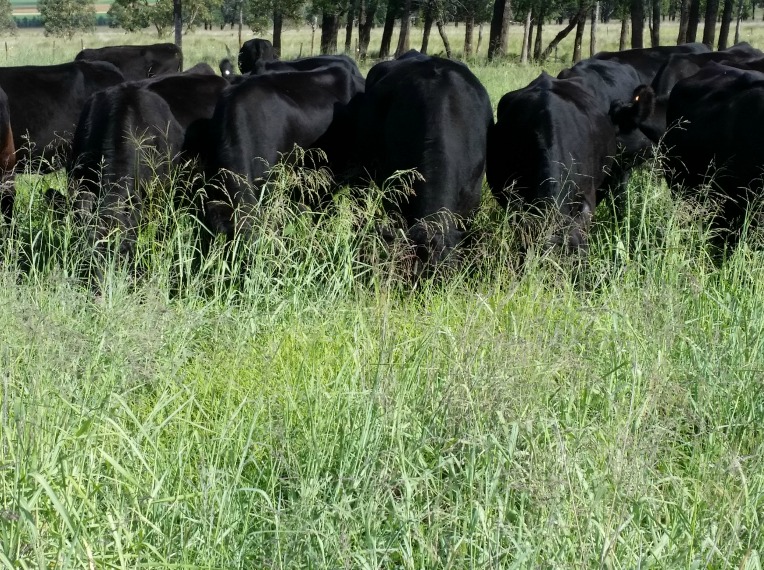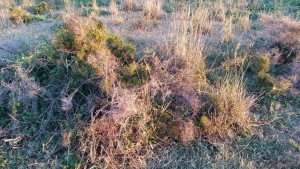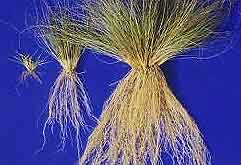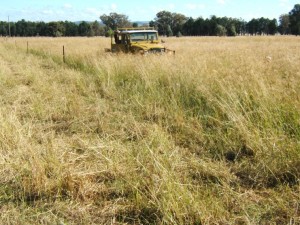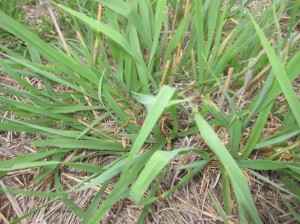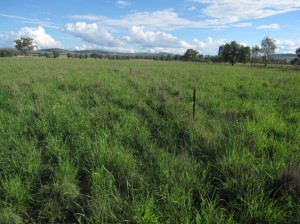All graziers must surely want to be able to grow more grass – more grass means more stock, which means more kilograms of beef or lamb (or whatever animal), which means more money, right? Well – only if managed correctly.
“Too much grass is a bigger problem than not enough grass”
This is something I was told once and my initial reaction was ‘What??!’. I’ve learnt that this CAN be right and I will explain why and when.
…. Years ago we began to manage our cattle under a planned grazing rotation and moved away from a set stock system. We saw lots of fantastic changes in our farm as a result of this changed management. These include:
- Dramatically increased ground cover
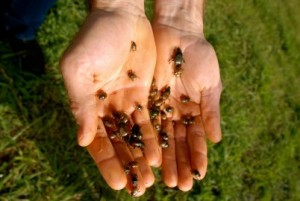
- A lack of weeds, as the opportunity for them to germinate disappeared together with the poor ground cover.
- Massive dungbeetle numbers
- Much improved water infiltration – evidenced by farm dams that now rarely fill (we water cattle from portable troughs supplied from our bore).
- When soils are saturated and do reach the point of runoff – it does so as beautiful clear runoff water.
- A succession to higher order pasture species.
- The natural regeneration of trees
- And LOTS more grass.
Let’s talk about the ‘lots more grass’.
[private]
The key to a planned grazing system is plant recovery. We graze a paddock down (or the cattle do) sometimes intensively and they are then moved onto the next block. The perennial pasture is then left to recover before being re-grazed. I will explain why this plant recovery is so important.
Plant Recovery
When a perennial grass is grazed it loses a proportion of its leaf area or above ground dry matter – which is eaten by the livestock and is obvious for us to see. What also happens (and not so obvious) is that the root system dies off proportionately to the top growth. This provides minerals and carbon (which has been pulled from the atmosphere via photosynthesis) to the soil, as well as encouraging and feeding soil biology. The plants then regrow, which involves both leaf and root growth – and so the cycle continues. Now, remember I said that plant recovery is the key to a planned grazing system? This is for a number of reasons:
Preventing overgrazing/ plant loss
In a set stock system, grasses are open to being constantly grazed during their growing period, with the leaf biomass rarely able to enlarge. So what are the root systems doing during this? As you will now know – their growth is only proportionate to that of the leaf area and is therefore restricted to just small amounts of growth in the top few inches of soil. Each time the plant re-grows, it uses what minimum reserves these small root systems can offer. Over time, such reserves run so low that the plant eventually dies. Loss of pasture species is a common problem of set stock systems. This leaves uncovered ground in the pasture, which provides the opportunity for less desirable annual weeds to establish in the pasture and for less palatable perennial species to dominate. Weed control via herbicides is often then taken out and eventually costly pasture renovation or replanting.
REGenerating soils
The other reason why plant recovery is so important is for the health of the soil. When adequate plant recovery is allowed, the roots will delve deeper into the soil than with a set stock system. As that deep rooted pasture delves deep into the soil, they are exuding carbon rich exudates into the soil at depth, which feeds soil microbiology throughout the profile. This provides carbon, minerals (made available by the microbiology) and moisture as the root system dies off after a grazing. The small tunnels left where roots die off, will also help to aerate the soil.
Under a set stock system, when root growth is limited, it not only limits the carbon and nutrition that can be placed deep in the soil, it also limits the ability of that plant to access deeper soil moisture. This is a very important point on our farm and many Australian farms, where moisture is often the most limiting input of our system.
As the cycle of recovery and grazing continues, the soil will build, as carbon and nutrients are placed deep in the soil – improving the water holding capacity, biology, nutrition and overall health of the soil – without external, unsustainable inputs.
Let’s look at some of these root systems.
The biomass of the roots and the tops of grasses are roughly equal, forming a mirror image. Short grasses (left) have a small root system.1
Healthier system
This system is healthier and sustainable –and even, excitingly, regenerative.
Planned grazing relies on the natural systems to rebuild the soil health. As photosynthesis occurs, the plant draws carbon from the atmosphere, converts it to plant sugars, where a portion of it is then released from the roots as exudates. These exudates feed soil microbes, which in turn make macro minerals and trace elements available to the plant (it’s like a trade between the two). Under a high input fertiliser system, the macro minerals are available to the plant, so there is no need for the release of exudates from the roots to feed the microbes which would then supply these nutrients to the plant. It’s like the feedback loop is interrupted. (See last week’s blog for a more detailed explanation of this).
This means that the accompanying trace elements are then not available to the plant. The two systems produce a similar looking plant, but it is very different with regard to the trace mineral density and make up. This lack of mineral density then reflects on the health of the animals feeding on it and in turn, the consumer of the produce or meat – which is us.
How fantastic to rely on a system of free carbon and sunlight, which also produces a better quality product?
Life in the real world – The practicalities of this
Whilst making sure plants have enough recovery (and preventing overgrazing) – getting the balance between this and animal performance is critical to productivity. This was something that we found a challenge as we learnt more about the system in our environment. Productivity of an animal is related to the digestibility of the pasture, which is directly related to the growth stage of the plant. The digestibility of plants decreases as the plant matures (due to increasing lignification of the plant material and decreasing energy levels). The challenge for us was to get the balance between achieving animal performance by grazing pastures at the optimal time whilst still achieving the positive pasture outcomes of pasture persistence, ground cover and soil health.
There is a short term advantage of a set stock grazing situation, in that stock will be grazing pastures when they are at their most palatable and of highest energy levels (just the new growth), which can produce good animal weight gains. In the long term however, the pastures won’t persist, soils will degrade, ground cover will be poor, rainfall won’t infiltrate as well and short root systems mean the pastures won’t utilise as much of the profile soil moisture that is present. The variety of nutrients in the pasture is most likely also detrimentally affected too (as soil biology is low), which may affect the health of animals feeding from it.
In a season with moderate growth, we have found the balance more easily achieved. A stocktake of dry matter quantities and an estimate of growth rates means that a plan can be created that matches feed supply with cattle feed consumption.
In a dry season, when growth has stopped, this is also quite easy, as there is a known quantity of feed that you can calculate to see if it will take you through to the time when the season typically breaks.
In a season of really rapid growth however, is when this becomes challenging. It is such conditions in the past, when we have experienced lower animal performance because we have had ‘too much grass’. We were unprepared for the amount of grass we would grow. We had combined cattle mobs to create a greater recovery time for our pastures, which grew us a lot more grass.
I will illustrate below.
Let’s assume I had 2 x 40ha paddocks, and a set number of cattle. I could graze paddock 1 for 20 days (for example), following which I would move them into paddock 2.
Scenario 1
|
Pdk 1
|
|
Pdk 2
|
Alternatively, I could break paddocks 1 & 2 into 4 x 5ha blocks.
Scenario 2
|
Pdk 1a |
Pdk 1b |
|
Pdk 1c |
Pdk 1d |
|
Pdk 2a |
Pdk 2b |
|
Pdk 2c |
Pdk 2d |
I could graze paddock 1 in this manner:
- 1a for 5 days
- 1b for 5 days
- 1c for 5 days
- 1d for 5 days
I would then move the cattle to paddock 2 (or 2a). So, I have grazed paddock 1 for 20 days – exactly the same time as in scenario 1. There is one significant difference however, in the first scenario the grass in paddock 1 is not recovering until day 21 when I move the cattle to paddock 2. In scenario 2 however, the grass in paddock 1a begins recovering (regrowing) from day 6, paddock 2 from day 11 and so on. Such that when the cattle are moved to paddock 2a, there has already been 15 days recovery or growth in paddock 1a, 10 days in paddock 1b etc. Multiply this effect over your whole farm and you start growing a LOT more grass (when in the growing season of the year).
Some of you may be lucky enough to be in a growing season most of the year, which is easier to manage as you can just increase your stocking numbers to keep up with the grass. If however, you have a really definite and strong growing season (which we do over summer with sub-tropical pasture species), followed by a pretty slow growing season (as we do over winter – and even more so in recent years) we need to either be flexible with cattle or stock numbers (and stock up in summer and (importantly) destock before the slow growth period) or make adjustments in our grazing plan for the mass of grass we grow. Increasing stock numbers is not always the best option for us, as it leaves us going into the slow growth period without a bulk of dry matter – which we sometimes come to rely on over this time.
I believe our problem was compounded by the fact that some of our summer growing pastures were subtropical species, which have such explosive growth which quickly decreases in digestibility. These species (known as C4 species) are also starting from a lower nutritional value, even when grazed at optimal time, than the C3 or temperate grasses.
Our Challenge
This ‘lot more grass’ was something we weren’t prepared for initially; which meant by the time we (or the cattle) came back to re-graze a paddock, the grass was already in a mature state. This meant low digestibility and low animal performance. This problem was exacerbated by our thought that we wanted to ‘eat down or bash down’ this mass of feed to promote feed for the next graze – which slowed the graze cycle further (as we tried to have our livestock consume much of the dry matter) and this further affected production. Ironically, bashing the grass down more, was really just promoting more growth and exacerbating our ‘too much grass’ problem.
What is also detrimental about this is once a grass is not actively growing, it is not releasing the exudates that a younger growing plant will, so the wonderful soil nutrient and carbon improvements that I mentioned above slow right down and will cease with the plant growth ceasing.
To avoid all of this, we now aim at either higher stock numbers during our fast growth seasons and/or drop paddocks out of the rotation. So, in the example above, paddock 1d could be completely skipped in the grazing plan, such that the livestock are back at paddock 1a while the grass is still more highly digestible. Paddock 1d comes back into the rotation in our dryer season, when all pasture growth of that species is of lower digestibility anyway. Paddock 1a becomes a priority paddock.
A key question to know the answer to in such a system is …..
What does a ‘recovered’ plant look like?
Seems like a simple question right? It is, however, very important that we get this right.
Below is a photo of a sub-tropical grass species that has just begun to recover after rain. You can see the old crown of the plant. As a guide, once the new growth is up and meets the full thickness of the old crown, then this is a good guide to a grass being recovered. Keep in mind that all species will be a little different.
We have a recovering grass on the left and recovered on the right.
At the other end of the grass’ growth cycle, it is quite simple to identify when a grass moves to a reproductive state and is no longer actively growing.
I mentioned the term priority paddock earlier, which is a paddock or paddocks that are always returned to for grazing as soon as their grasses are recovered. The most improvement in soil and pastures can be expected from these priority paddocks, as the process of graze and regrowth is intensified allowing maximum root growth and root exudation into the soil.
It is critical however, in a planned grazing situation, to maintain flexibility. A different set of priority paddocks must be chosen each year and the paddocks dropped out of the rotation one season must be reintroduced next season. Pasture growth varies all the time depending on season, rainfall and species, and to get into a set timing of rotations will ultimately fail, with either poor animal performance or through poor pasture persistence, or both.
The more that we can have plants growing all year round, the better we can feed soil biology and increase soil quality and the quality of products that we produce from it. On our farm we do have a period of slower growth over winter, which we try and fill with clovers, vetches and winter active lucerne, but this relies a bit on the season going with us. Another real potential to keep microbes active all year round is with pasture cropping, which you can learn about from one of my previous blogs. We are planning on pasture cropping some of our summer active pastures next winter, with a fodder crop, to help fill the gap of quality feed in winter and to help improve diversity in our pastures. We plan on a mixed species crop.
So, ‘is too much grass a worse problem that not enough’?
Going back to one of the initial comments from this blog – is too much grass a worse problem than not enough? The point that this person was getting at was that it is difficult to get on top of a lot of mature grass once we have it. But, providing that we have SOME amount of growth (however slow), by combining mobs or splitting up paddocks into smaller blocks (which can be done quite simply with an electric wire), we can immediately start affecting MORE grass. As can be understood from my diagrams above.
The washup of all of this is good news! We can all grow a lot more grass when we change our grazing management – and not only this, we can regenerate soils while we do it, which is a fantastic thing. We just need to be prepared for how to react to a lot more grass! That’s what I call a quality problem!!
Yours in conscious farming,
Kirrily.
* What are the challenges and advantages under your environment?
References
- Jones, C.(2006) Grazing Management for Healthy Soils. http://grazingmanagement.blogspot.com.au/ 27th Nov 2013.

